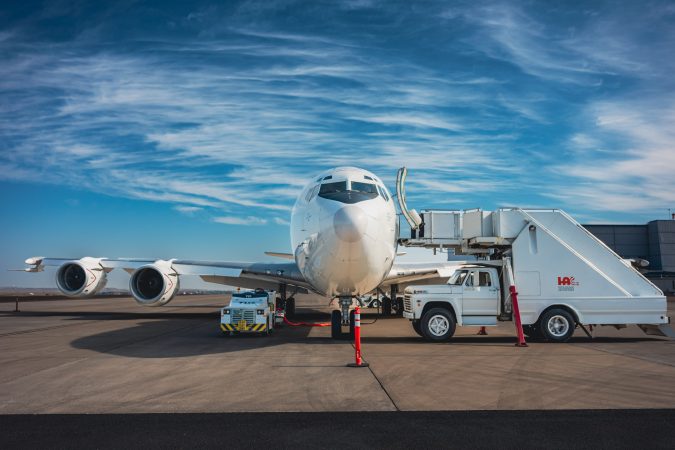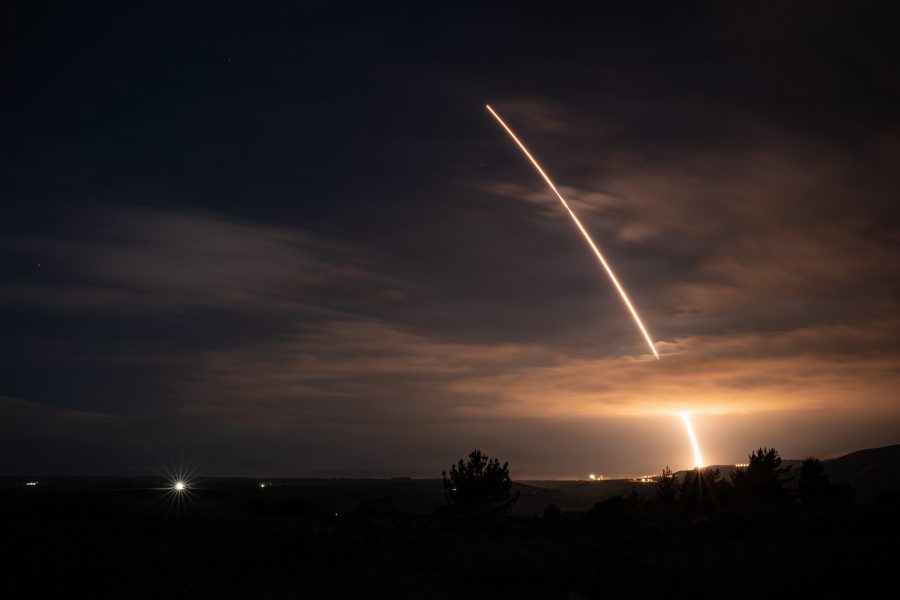Air Force Global Strike Command tested an unarmed Minuteman III intercontinental ballistic missile in the early hours of Nov. 5, the service announced.
The test, the latest in a series of launches that have been carried out at regular intervals for decades, came as Russian President Vladimir Putin has touted the development of two new nuclear weapons and President Donald Trump has suggested in recent days that the U.S. might resume nuclear testing.
The ICBM launched from Vandenberg Space Base, Calif., at 1:35 a.m. Pacific Time and traveled some 4,200 miles to a test range in the Pacific after receiving launch orders from an airborne nuclear command and control plane.
The test, known as a Glory Trip or GT, was commanded from a U.S. Navy E-6B Mercury test aircraft, rather than missileers at Vandenberg, who are on standby. The U.S. military test fires the missile roughly once a year from the Navy command and control plane to be sure Minuteman III missiles can be launched in the event of a nuclear attack or other incident that could disable a ground-based launch control center.
AFGSC Airmen from the 625th Strategic Operations Squadron used the so-called Airborne Launch Control System aboard the E-6B.
“GT 254 is not just a launch—it’s a comprehensive assessment to verify and validate the ICBM system’s ability to perform its critical mission,” Lt. Col. Karrie Wray, commander of the 576th Flight Test Squadron, a dedicated ICBM test unit, said in a news release. “The data collected during the test is invaluable in ensuring the continued reliability and accuracy of the ICBM weapon system.”

For Minuteman III tests, the Air Force pulls its missiles from the fleet of some 400 operational ICBMs. The Nov. 5 test used one from F.E. Warren Air Force Base, Wyo., and the missile was equipped with a single unarmed reentry vehicle that carried telemetry instrumentation—officially known as an Instrumented Joint Test Assembly—instead of a warhead, service officials said.
The reentry vehicle impacted the Reagan Test Site on the Kwajalein Atoll in the Marshall Islands roughly 30 minutes later. The Reagan Test Site is equipped with advanced sensors to monitor the impact of ICBM tests.
The launch was overseen by the 377th Test and Evaluation Group, which is responsible for planning and executing the launch and compiling data afterwards about the test.
“This test validated the reliability, adaptability, and modularity of the weapon system,” Col. Dustin Harmon, 377th Test and Evaluation Group commander, said in a release.
The Minuteman III was originally supposed to be replaced in the 2030s, but delays with the new Senintel ICBM’s infrastructure have led the Air Force official to suggest the Minuteman III may need to be kept in service longer, potentially even until 2050.
An unclassified version of a Government Accountability Office report released to the public in September noted that the Air Force originally said the Minuteman III would end its service life in 2026. “Now, facing delays to Sentinel, the Air Force is evaluating options to continue operating Minuteman III through 2050. The Minuteman III Program Office concluded that operation of Minuteman III until 2050 is feasible,” the GAO wrote in its report.
The LGM-35A Sentinel is scheduled to replace the fielded Minuteman III missiles on a one-for-one basis and was previously expected to start entering service in 2030. That now appears unlikely, and contractor Northrop Grumman said in July it agreed to a “re-establishment of the program baseline” with the Air Force.
“As we modernize to the Sentinel weapon system, we must continue to maintain the readiness of the existing Minuteman III fleet,” said Gen. S.L. Davis, the new commander of Air Force Global Strike Commander, in a release. “GT 254 helps fulfill that commitment, ensuring its continued accuracy and reliability.”
The Department of Defense promoted the launch on social media, posting on X, “Under [Trump] and [Secretary of Defense Pete Hegseth], we have PEACE THROUGH STRENGTH.” Minuteman III tests have been regularly carried out under the administrations of both parties.
The launch came days after Trump suggested on multiple occasions that the U.S. may resume nuclear weapons testing. The U.S. has not conducted a nuclear weapons test since 1992.
In an interview that aired Nov. 2 on CBS’s “60 Minutes,” Trump said that Russia and China were conducting underground tests of nuclear weapons, and in social media posts as recently as Nov. 5, Trump has said the U.S. should test on “an equal basis.”
“Russia’s testing and China’s testing, but they don’t talk about it,” Trump said during his television interview without providing evidence.
Russia and China say they have been observing a moratorium on underground tests for decades.
The State Department has said in arms control reports that Russia is believed to have carried out some small nuclear experiments between 1996 and 2019 that have produced a “nuclear yield.” In 2020, the State Department said it had “concerns” that China might also be carrying out similar nuclear tests with very low explosive power.
The White House has not provided details on what sort of tests Trump had in mind, and whether they include the very low-yield tests that Russia and China may have done.
Some in Washington are skeptical that Trump was foreshadowing a return to substantial nuclear tests.
“The possibility that we’ll be blowing up the Bikini Atoll again—the president just says stuff,” Rep. Jim Himes (D-Conn.), the ranking member on the House Permanent Select Committee on Intelligence, said in a Nov. 4 appearance before the Council on Foreign Relations. “We have a triad. We’ve got three ways to deliver strategic nuclear weapons. … If you start testing again, if you start getting back into a Cold War mindset … all you really achieve is an unstrategic focus and a shocking amount of money.”


